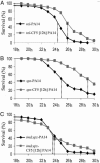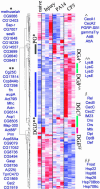Profiling early infection responses: Pseudomonas aeruginosa eludes host defenses by suppressing antimicrobial peptide gene expression
- PMID: 15695583
- PMCID: PMC549001
- DOI: 10.1073/pnas.0409588102
Profiling early infection responses: Pseudomonas aeruginosa eludes host defenses by suppressing antimicrobial peptide gene expression
Abstract
Insights into the host factors and mechanisms mediating the primary host responses after pathogen presentation remain limited, due in part to the complexity and genetic intractability of host systems. Here, we employ the model Drosophila melanogaster to dissect and identify early host responses that function in the initiation and progression of Pseudomonas aeruginosa pathogenesis. First, we use immune potentiation and genetic studies to demonstrate that flies mount a heightened defense against the highly virulent P. aeruginosa strain PA14 when first inoculated with strain CF5, which is avirulent in flies; this effect is mediated via the Imd and Toll signaling pathways. Second, we use whole-genome expression profiling to assess and compare the Drosophila early defense responses triggered by the PA14 vs. CF5 strains to identify genes whose expression patterns are different in susceptible vs. resistant host-pathogen interactions, respectively. Our results identify pathogenesis- and defense-specific genes and uncover a previously undescribed mechanism used by P. aeruginosa in the initial stages of its host interaction: suppression of Drosophila defense responses by limiting antimicrobial peptide gene expression. These results provide insights into the genetic factors that mediate or restrict pathogenesis during the early stages of the bacterial-host interaction to advance our understanding of P. aeruginosa-human infections.
Figures





Similar articles
-
The Drosophila melanogaster toll pathway participates in resistance to infection by the gram-negative human pathogen Pseudomonas aeruginosa.Infect Immun. 2003 Jul;71(7):4059-66. doi: 10.1128/IAI.71.7.4059-4066.2003. Infect Immun. 2003. PMID: 12819096 Free PMC article.
-
Pseudomonas aeruginosa RhlR is required to neutralize the cellular immune response in a Drosophila melanogaster oral infection model.Proc Natl Acad Sci U S A. 2011 Oct 18;108(42):17378-83. doi: 10.1073/pnas.1114907108. Epub 2011 Oct 10. Proc Natl Acad Sci U S A. 2011. PMID: 21987808 Free PMC article.
-
Pseudomonas aeruginosa suppresses host immunity by activating the DAF-2 insulin-like signaling pathway in Caenorhabditis elegans.PLoS Pathog. 2008 Oct;4(10):e1000175. doi: 10.1371/journal.ppat.1000175. Epub 2008 Oct 17. PLoS Pathog. 2008. PMID: 18927620 Free PMC article.
-
Immune surveillance mechanisms of the skin against the stealth infection strategy of Pseudomonas aeruginosa-review.Comp Immunol Microbiol Infect Dis. 2013 Sep;36(5):433-48. doi: 10.1016/j.cimid.2013.03.003. Epub 2013 Apr 17. Comp Immunol Microbiol Infect Dis. 2013. PMID: 23602428 Review.
-
Regulators of the Toll and Imd pathways in the Drosophila innate immune response.Trends Immunol. 2005 Apr;26(4):193-8. doi: 10.1016/j.it.2005.02.006. Trends Immunol. 2005. PMID: 15797509 Review.
Cited by
-
Massively parallel mutant selection identifies genetic determinants of Pseudomonas aeruginosa colonization of Drosophila melanogaster.mSystems. 2024 Mar 19;9(3):e0131723. doi: 10.1128/msystems.01317-23. Epub 2024 Feb 21. mSystems. 2024. PMID: 38380971 Free PMC article.
-
Immune response to bacteria induces dissemination of Ras-activated Drosophila hindgut cells.EMBO Rep. 2012 Jun 1;13(6):569-76. doi: 10.1038/embor.2012.44. EMBO Rep. 2012. PMID: 22498775 Free PMC article.
-
Drosophila melanogaster as a model host for studying Pseudomonas aeruginosa infection.Nat Protoc. 2009;4(9):1285-94. doi: 10.1038/nprot.2009.124. Epub 2009 Aug 13. Nat Protoc. 2009. PMID: 19680242
-
Drosophila melanogaster as a model host for the Burkholderia cepacia complex.PLoS One. 2010 Jul 12;5(7):e11467. doi: 10.1371/journal.pone.0011467. PLoS One. 2010. PMID: 20635002 Free PMC article.
-
Peroxiredoxin 5 modulates immune response in Drosophila.Biochim Biophys Acta. 2010 Nov;1800(11):1153-63. doi: 10.1016/j.bbagen.2010.06.010. Epub 2010 Jun 28. Biochim Biophys Acta. 2010. PMID: 20600624 Free PMC article.
References
-
- Medzhitov, R. & Janeway, C., Jr. (2000) Immunol. Rev. 173, 89-97. - PubMed
-
- Tzou, P., Ohresser, S., Ferrandon, D., Capovilla, M., Reichhart, J. M., Lemaitre, B., Hoffmann, J. A. & Imler, J. L. (2000) Immunity 13, 737-748. - PubMed
-
- Hoffmann, J. A. & Reichhart, J. M. (2002) Nat. Immunol. 3, 121-126. - PubMed
-
- Hetru, C., Troxler, L. & Hoffmann, J. A. (2003) J. Infect. Dis. 187, Suppl. 2, S327-S334. - PubMed
Publication types
MeSH terms
Substances
LinkOut - more resources
Full Text Sources
Other Literature Sources
Molecular Biology Databases

